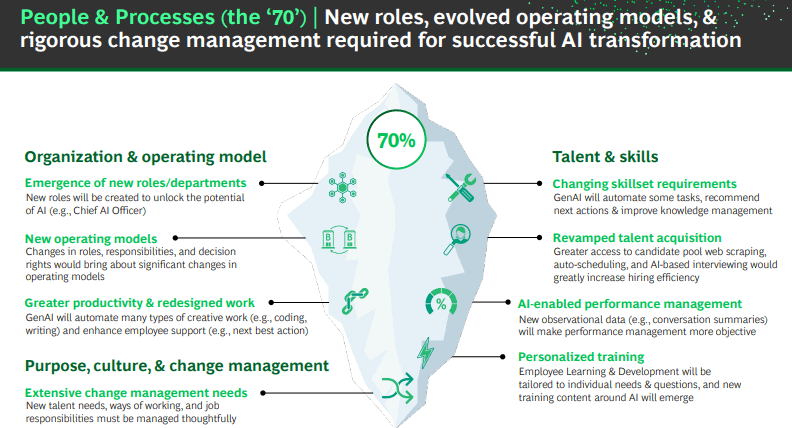Table of Contents
- Time to Act
- The Three Complementary Strategies to Maximize AI’s Potential Value
- Three Pillars for a Successful Transformation
- Key Steps
The strategic consulting giant, Boston Consulting Group (BCG), has created a new guide aimed at CEOs, to move beyond the hype surrounding artificial intelligence (AI) and understanding what creates value today and what will create it in the future. Let’s review the most important points together.
Time to Act
AI technologies are reaching a new stage of maturity, offering organizations tangible and lasting value. The most advanced companies in adoption, about 10%, have been the first to scale by adopting this technology with a strategic vision, setting ambitious goals, and aiming for significant growth in both revenue and profits, thereby widening the gap with their competitors.
Meanwhile, AI technology continues to evolve rapidly, moving from established, scalable solutions to exciting innovations on the horizon. Not investing in AI technologies today could mean falling behind not only competitors but also the entire market.
The Three Complementary Strategies to Maximize AI’s Potential Value
According to BCG, the first step in maximizing the value of AI projects is to have a clear and structured strategy that revolves around three fundamental points:
- Deploy: Focus on adopting ready-made tools that increase staff productivity, improve employee satisfaction, and generate enthusiasm for broader AI-driven change within the organization. This strategy aims for a 10-15% productivity increase.
- Reshape: Involves reimagining functions by reengineering workflows to achieve 30-50% improvements in efficiency and effectiveness in the targeted functions. “Reshape” interventions focus on critical functions and aim to achieve significant improvements in efficiency, execution speed, and ROI.
- Invent: Leverages AI to expand revenue streams and introduce new offerings, services, and experiences to the market. By exploiting AI, new value propositions can be created for customers, new products or services can be developed, new target customers can be reached, and new pricing/cost structures for existing products or services can be established.
Three Pillars for a Successful Transformation
Talent, technological infrastructure, and a 10-20-70 approach to focus on people and processes rather than algorithms and technology. These are the fundamental pillars for a successful transformation. Let’s understand together what they consist of.
BCG’s recommended 10-20-70 approach suggests dedicating only 10% of AI efforts to algorithms, 20% to technology and data, and instead allocating the majority of the effort, 70%, to people and processes. Engaging employees and fostering a culture that embraces these tools is essential for success. Change management must be attentive to adjustments in organizational structures and decision-making processes, as more than two-thirds of transformations fail due to shortcomings in this area.
AI is also transforming performance management, making it more objective thanks to new data and insights, and personalizing employee learning and development. Moreover, generative AI will automate tasks and offer recommendations, improving productivity.
Companies must invest in talent development, create a governance structure for AI, and integrate these tools into daily work, training employees to make the most of them. AI transformation should be viewed, according to BCG, with a holistic approach involving both people and processes.

Key Steps
Finally, the guide offers a framework for the practical steps to take in starting a valuable journey toward artificial intelligence:
- Know the Starting Point: Understand the current level of AI maturity in your organization.
- Prioritize High-Value Initiatives: Identify 3-5 functions or processes for each strategic initiative—Deploy, Reshape, and Invent—to focus efforts and resources, aiming for a significant return on investment.
- Upskill and Scale: Adopt AI tools in daily work, train employees, and scale.
- Fund the Journey: Centralize resources, streamline applications, and reduce third-party expenses in the first 6-12 months to optimize technology and digital costs. Align the portfolio with value-creating initiatives and shift investments accordingly.
- Build Fundamental Capabilities: Focus on building the capabilities that will drive and sustain the transformation, including technology, people, and data management.
- Initiate a Controlled Experimentation System: Develop a framework that allows for broad but controlled experimentation to maximize learning and innovation.
Discover how Neodata can help your company launch an artificial intelligence project by contacting us at info@neodatagroup.ai. We are here to support you on your innovation journey.
Neodata AI Team
As Neodata, we provide data, insight, articles, and news related to AI and Big Data.
- Neodata AI Team#molongui-disabled-link
- Neodata AI Team#molongui-disabled-link
- Neodata AI Team#molongui-disabled-link
- Neodata AI Team#molongui-disabled-link